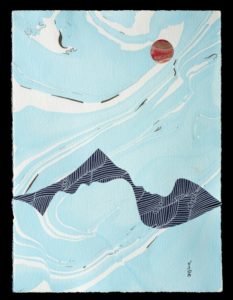Sooke-based mixed-medium artist Maurina Joaquin is using her work to dive deep into transformations. In particular, in her new exhibit Natural Transformations she’s exploring the changes that people who are recovering from trauma, a brain injury, or chronic pain go through.
“The silhouette heads [used in pieces in the exhibit] represent the individual struggle to not just belong, but to come back to this society,” says Joaquin. “In the state of chaos, in the height of recovery, sometimes you don’t think you’re ever going to get anywhere.”

Joaquin first started crafting at an early age with her grandmother. Although influential, her earlier years of crafting played a small role toward her becoming an artist. Her work in this exhibit in particular was driven from her experience at the Victoria Brain Injury Society and observing others in the classes.
“We are all dealing with a similar thing—what does work look like for us? Who’s going to hire us? That’s where I thought about what I could do to help them figure out what they needed to figure out—through art—because many do not see art as a medium of healing,” she says.
Due to the difficulties of reading and writing, Joaquin was drawn to visual arts as a way of expression. Searching for ways to relax after cognitive therapy, she discovered suminagashi—a Japanese art form of floating ink on water with paper—as well as printmaking and, before long, started incorporating collage, printmaking, and suminagashi together.
“I like collage because I could just rip and tear with no rhyme or reason, then as I moved into suminagashi, I could just cut around the shapes and create an abstract,” says Joaquin. “I stumbled into suminagashi in 2013 as a way of relaxing because I had such terrible nightmares I couldn’t sleep.”
The exhibit expresses this journey, starting with Future and ending with Bloom. The first is a collage of a chaotic silhouette on papyrus paper. Then, there’s suminagashi, and, nearing the end of the exhibit, there are crisp cut-outs of different print and embossment.
“The exhibit reflects those changes we go through during recovery,” she says. “When you look at the first one it is all chaotic within the individual, but as you go through you see The Mountains We Climb and see the ups and downs.”
Although her grandmother did not strongly influence Joaquin’s artwork, she did influence her approach to healing. Joaquin has memories of her grandmother putting vinegar on her temples and getting her to rest to treat her headaches. Joaquin’s grandmother also showed patience with her own body rhythm and healing speed.
“She uses her body’s instinct to heal and uses rest, for sure,” says Joaquin. “She taught me to decide my body’s time to heal, not society’s timeline.”
For many individuals dealing with mental-health issues, living in a busy society can be challenging to navigate. Joaquin’s artwork addresses these challenges for the sufferer and illustrates how art can be used as an effective way of dealing with the challenges of recovery.
“With PTSD, I find I’m most comfortable when I’m just inside the house and I’m not with people around,” she says. “This is why I challenged myself to do a solo show—it’s nerve wracking, and I was terrified, but I feel that by being fearful, I am also fearless.”
Natural Transformations
Until Tuesday, July 19
theDock
thedockvictoria.com
